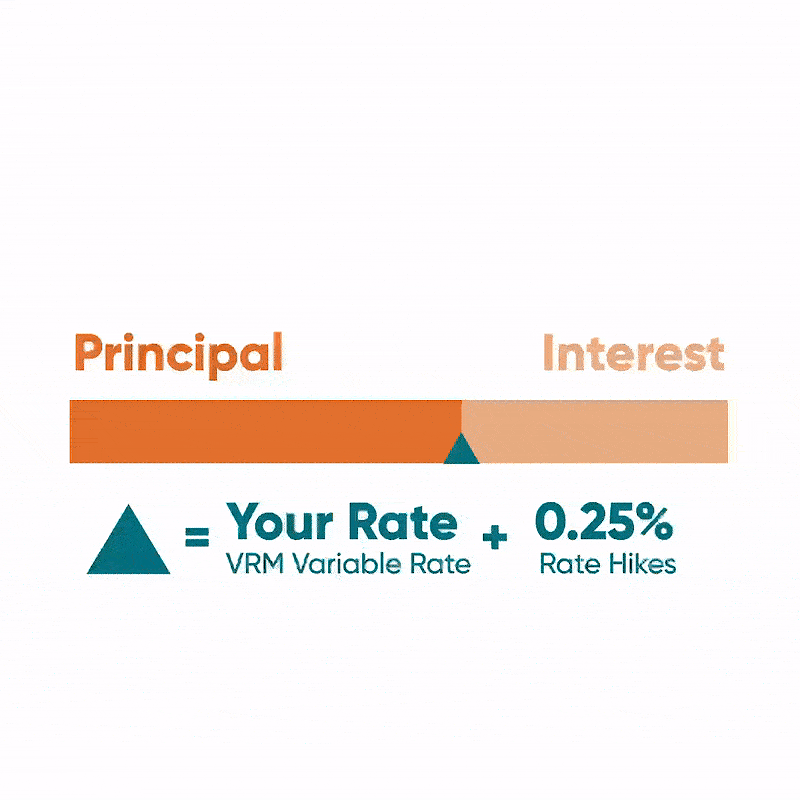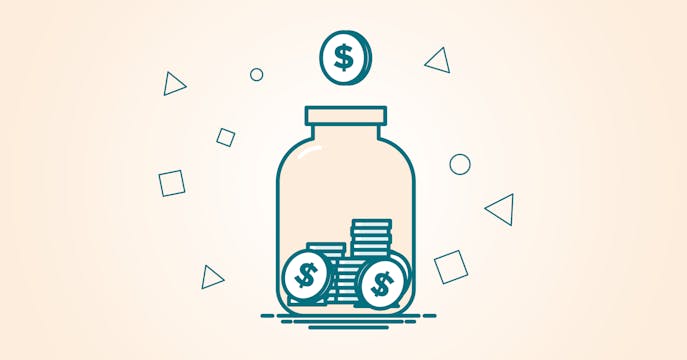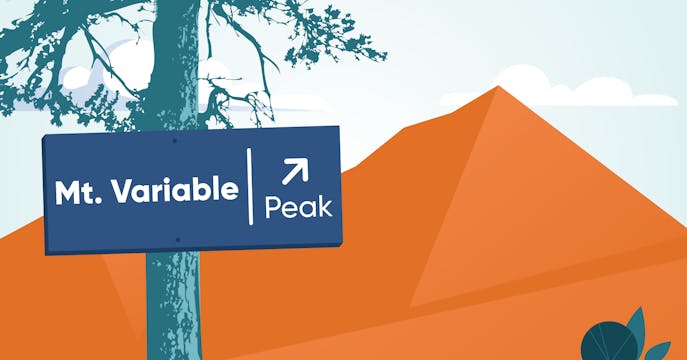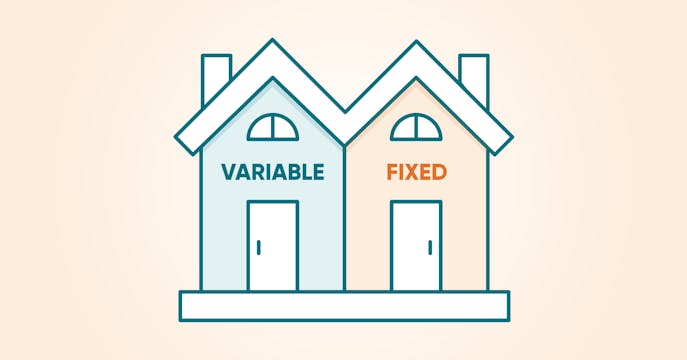Keeping an eye out for variable rates: You're more likely to hit your trigger rate sooner if you lock in with a lower variable rate and they move higher quickly, rather than if a few variable-rate increases are spread out during the length of your term.
Have you hit your trigger rate?
Your fixed payment variable-rate mortgage (VRM) has points of caution to watch out for.
Your trigger rate and trigger point are bumps in the (mortgage) road and can affect your goals. Here are some tips to stay on track.
Are you a THINK Financial client? You have an ARM product which doesn't have a trigger rate.
Some big banks offer VRMs, which do contain a trigger rate.
Caution ahead! What's good for your budget now may be a hazard later.
Back when rates were so low, no one was concerned when they got their variable-rate mortgage product through a big bank, and their payments were fixed for their term (meaning they wouldn't change along with prime rate movements like a standard 'adjusting' variable-rate mortgage).
Since then, many have learned about obstacles lying in wait with this mortgage product — because variable rates have skyrocketed at the fastest pace since the 1990s.
Those obstacles are called a trigger rate and trigger point, with negative amortizing a likely result of either.
It all means you're in for payment shock at renewal unless you take steps to keep your mortgage goals on track.
What is a trigger rate?
A trigger rate, identified in your variable mortgage fine print, is the rate reached (as a result of prime rate increases) where your fixed payment is only paying interest with nothing going towards the mortgage principal. Any interest not covered is being added to your mortgage balance.
Hitting your trigger point means your mortgage balance has grown beyond the lender's acceptable ratio for the amount of equity you need to hold vs. the purchase value of your home. (Read more about your trigger point here).
And with less (or nothing) going toward your mortgage principal, you could have a growing negative amortization, meaning your loan length is extending beyond your orginal contract.
At your next renewal, your amortization will be reset back to your original schedule minus time, resulting in a shock of much higher payments than you might have anticipated or budgeted for. And that's not including facing potentially higher market mortgage rates.

The Trigger-Rate Effect (on your mortgage payment).
For your fixed payment variable-rate mortgage (VRM), your payment amount is set at the beginning of your term. The interest and principal portions are based on your contract rate (including lender discount) and amortization schedule.
If variable rates go up, so does your interest portion, with less going to the principal (read that as 'your amortization is ticking up'). But as you can see, you're paying less and less down on principal well before you hit your trigger rate.
Hitting your trigger rate is your payment's 'last gasp' in that it no longer works for your mortgage terms, and the interest portion has consumed your entire payment amount.
Why is there a trigger rate?
When your payments are fixed despite a variable rate, something else in your mortgage has to give when prime rates move up or down (usually along with a Bank of Canada rate announcement).
That something is how much of your payment is going to interest instead of principal. If your whole payment is going towards interest — that's probably not what you intended for your mortgage goals and potential savings with a variable rate in the first place. And if your amortization is increasing, it'll cost you more for the longer time it will take to pay off your mortgage.
At this point, the lender should contact you to raise your payment (along with other options if you'd prefer to keep your payment amount unchanged).
How can you avoid payment shock at renewal?
Here are some steps to reduce your risk of much higher payments at renewal if you hit and surpass your trigger rate.
1. Know your trigger rate.
Each big bank has its own way of calculating trigger rates, and even though it's noted in your mortgage fine print (or should be), the trigger-rate goal post can move based on many factors, including previous payment frequency changes or pre-payments made towards your principal.
Contact your bank's mortgage rep or, better yet, talk to your expert True North Mortgage broker to help pinpoint your trigger based on your contract and payment history.
Once you know your trigger rate, you can make more informed decisions if variable rates start to rise.
2. Ask your lender to increase your mortgage payment.
If variable rates go up during your term, long before hitting your trigger rate and your lender contacts you to take action, you may want to think about having your payment increased.
Remember that with each rate increase, your payment doesn't adjust, so you're already paying less principal, which means your amortization is getting longer. Even if you don't hit your trigger rate, you'll be in for quite the payment surprise when it comes time to renew — assuming rates don't come down enough or in time to erase the deficit.
Your amortization could double (or more) if you leave your payment unbalanced after a few interest rate hikes.
Being proactive in adjusting your budget with a higher payment now rather than waiting can help you keep your financial goals within sight as you continue to pay down your mortgage.
3. Pay a sufficient lump sum to make your current payment workable again.
If you have extra cash, your broker or lender can help you determine a lump sum amount to put down on your principal that will align your current payment back to your original schedule — or close enough to an amortization that you might better handle at renewal.
The idea is that with every payment after you've placed the lump sum, your amortization should tick down, not go up, but any amount you can manage may help ease a shock later.
4. Switch to a fixed rate.
If you feel you want 'out' — to escape your VRM product to the relative safety of a fixed-rate mortgage — you can break your current term with a 3-month interest penalty (usually less costly than an IRD involved in breaking a fixed-rate mortgage).
Your expert broker can help you decide if your best fixed rate and the penalty involved make (mortgage) sense for your situation and financial goals and to leave your 'trigger point' in the rearview mirror.
5. Take action when your lender contacts you.
If rates go up and you get contacted by your lender, take heed. They'll outline the above options and may even insist on action to avoid the coming payment shock.
What happens if you don't trigger action — and you reach your trigger point?
Some clients, for example, who own rental properties, are okay with waiting for the trigger rate to set any payment changes in motion.
However, the risk is getting caught in the lender's (mortgage) headlights once again by next hitting your trigger point (exceeding a loan amount allowed by the lender based on your purchase price).
Again, the lender will contact you to make a change, such as higher payments, paying a lump sum or switching to a fixed rate — with a finite deadline, usually 30 days. The home can also be re-appraised to determine its Fair Market Value in relation to your loan percentage of the home's price.
This trigger-point marker is an even bigger deal than your trigger rate. The lender is now at higher risk for carrying your mortgage loan, and the next fall-down is mortgage default.
Prepare for what's up the (mortgage) road.
So, while it may seem easy with a busy schedule to wait for the lender to contact you about your VRM's trigger rate, having a proactive strategy will help you stay on top of your mortgage savings goals.
Talk to us! We're highly trained with the experience and service focus to help you navigate the (mortgage) road — and ride out into the sunset while saving thousands on your mortgage.
We're here for you, anywhere you are in Canada — online, over the phone or at a store location. Give us a shout! You'll get 5-star service and an easy process to make clear decisions.
We're the headlights illuminating your path to savings.
Other ways we save you more

All the ways to save on your mortgage.
Here are 12 great tips to help calm your (mortgage) budget woes.

Have variable rates peaked?
After an arduous rate rise — are there savings to snag on the climb down?

Variable vs Fixed Mortgage Rates
Which rate type works best for you, variable or fixed? Some pros and cons to help you decide.

